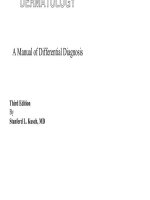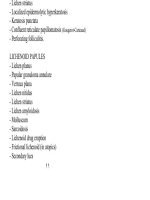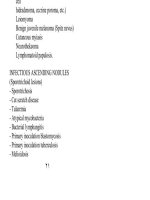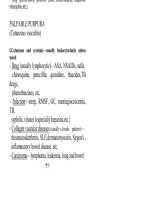Churchills pocketbook of differential diagnosis, 4enewmedicalbooks
Bạn đang xem bản rút gọn của tài liệu. Xem và tải ngay bản đầy đủ của tài liệu tại đây (19.86 MB, 612 trang )
CHURCHILL’S POCKETBOOK OF
ir
s.
an
s
si
er
p.
p
vi
ta
hi
r9
9
-U
ni
te
dV
R
G
Differential Diagnosis
SECTION A
tahir99 - UnitedVRG
vip.persianss.ir
G
R
dV
te
vi
p.
p
er
si
an
s
s.
ir
ni
-U
9
r9
hi
ta
Content Strategist: Laurence Hunter
Content Development Specialist: Sheila Black
Project Managers: Lucia Perez, Caroline Jones
Designer: Miles Hitchen
tahir99 - UnitedVRG
vip.persianss.ir
CHURCHILL’S POCKETBOOK OF
Differential
Diagnosis
Andrew T. Raftery BSc MB ChB(Hons) MD
ni
te
dV
R
G
FRCS(Eng) FRCS(Ed)
Clinical Anatomist, Honorary Teaching Fellow, Hull York Medical School;
Formerly Consultant Surgeon, Sheffield Kidney Institute, Sheffield
Teaching Hospitals NHS Foundation Trust, Northern General Hospital,
Sheffield; Member (formerly Chairman), Court of Examiners, Royal
College of Surgeons of England; Formerly Member of Panel of
Examiners, Intercollegiate Speciality Board in General Surgery; Formerly
Member of Council, Royal College of Surgeons of England; Formerly
Honorary Clinical Senior Lecturer in Surgery, University of Sheffield, UK
ir
-U
Eric Lim MB ChB MD MSc FRCS(C-Th)
s.
an
s
9
Consultant Thoracic Surgeon, Royal Brompton Hospital, London;
Senior Lecturer, National Heart and Lung Institute, Imperial College,
London, UK
r9
Andrew J. K. Östör MB BS FRACP
si
er
p.
p
ta
hi
Consultant Rheumatologist and Associate Lecturer, Addenbrooke’s
Hospital, Cambridge; Director, Rheumatology Clinical Research Unit,
School of Clinical Medicine, University of Cambridge, Cambridge, UK
vi
FOURTH EDITION
vip.persianss.ir
SECTION A
EDINBURGH LONDON NEW YORK OXFORD
PHILADELPHIA ST LOUIS SYDNEY TORONTO
2014
tahir99
- UnitedVRG
© 2014 Elsevier Ltd. All rights reserved.
No part of this publication may be reproduced or transmitted in any form or by
any means, electronic or mechanical, including photocopying, recording, or any
information storage and retrieval system, without permission in writing from
the publisher. Details on how to seek permission, further information about the
Publisher’s permissions policies and our arrangements with organizations such
as the Copyright Clearance Center and the Copyright Licensing Agency, can be
found at our website: www.elsevier.com/permissions.
This book and the individual contributions contained in it are protected under
copyright by the Publisher (other than as may be noted herein).
G
First edition 2001
Second edition 2005
Third edition 2010
Fourth edition 2014
dV
R
ISBN 978-0-7020-5402-0
International ISBN 978-0-7020-5403-7
E-book ISBN 978-0-7020-5404-4
British Library Cataloguing in Publication Data
A catalogue record for this book is available from the British Library
te
Library of Congress Cataloging in Publication Data
A catalog record for this book is available from the Library of Congress
ir
-U
ni
Notices
Knowledge and best practice in this field are constantly changing. As new
research and experience broaden our understanding, changes in research
methods, professional practices, or medical treatment may become necessary.
s.
an
s
9
Practitioners and researchers must always rely on their own experience and
knowledge in evaluating and using any information, methods, compounds, or
experiments described herein. In using such information or methods they should
be mindful of their own safety and the safety of others, including parties for
whom they have a professional responsibility.
si
er
p.
p
ta
hi
r9
With respect to any drug or pharmaceutical products identified, readers are
advised to check the most current information provided (i) on procedures
featured or (ii) by the manufacturer of each product to be administered,
to verify the recommended dose or formula, the method and duration of
administration, and contraindications. It is the responsibility of practitioners,
relying on their own experience and knowledge of their patients, to make
diagnoses, to determine dosages and the best treatment for each individual
patient, and to take all appropriate safety precautions.
vi
To the fullest extent of the law, neither the Publisher nor the authors,
contributors, or editors, assume any liability for any injury and/or damage to
persons or property as a matter of products liability, negligence or otherwise,
or from any use or operation of any methods, products, instructions, or ideas
contained in the material herein.
Printed in China
tahir99 - UnitedVRG
vip.persianss.ir
PREFACE
ir
p.
p
er
si
an
s
s.
A.T.R. Sheffield
E.L. London
A.J.K.O. Cambridge
2014
vi
ta
hi
r9
9
-U
ni
te
dV
R
G
We are grateful to the publishers, Elsevier, for the invitation to
produce a fourth edition of the Pocketbook of Differential Diagnosis.
The text has been updated and some further conditions added.
We have been pleased by the comments from our readership, who
have suggested additions and corrections, and these have been taken
into account when writing this new edition. The introduction of the
colour coding system in the third edition was favourably received
and has been retained in this edition, with a few modifications in
the grading of the relative frequency of some conditions. A number
of our readers felt that the addition of illustrations would be helpful
and to that end, we have added these to some of the chapters where
we thought it appropriate. Readers and reviewers also suggested
that the addition of management of diseases would be helpful but
this book is a manual of differential diagnosis; treatment of the
various conditions is outside the scope of this book.
We are pleased with the way that previous editions have sold and
that, in these days of self-directed problem-based learning, medical
students still see the need for a book offering a didactic approach.
Indeed, we believe that the book will be particularly helpful to those
on problem-based learning courses. We hope this book will continue
to help you on the wards and in the clinics – and in examinations!
SECTION A
tahir99 - UnitedVRG
vip.persianss.ir
viACKNOWLEDGEMENTS
We are extremely grateful to Elsevier and, in particular, to Laurence
Hunter, Senior Content Strategist, and Sheila Black, Content
Development Specialist, for their support and help with this project.
We wish to thank all those who have contributed to the successive
editions of this book. We would particularly like to express our
thanks to our junior staff and medical students who have suggested
corrections, amendments and improvements to the book. Any
errors that may have occurred remain our responsibility. We are also
indebted to our consultant radiologist colleagues at the Sheffield
Teaching Hospitals NHS Foundation Trust who provided images:
Matthew Bull, Michael Collins, Peter Brown, Tim Hodgson and
Adrian Highland and to Angela Lord for permission to use figure
58. We would also like to thank our wives for their patience and
encouragement shown throughout the production of this fourth
edition. Mr Raftery would like to thank his secretary, Mrs Denise
Smith, for the hard work and long hours she has put into typing
and re-typing the manuscript into its final form for publication
(Mr Raftery cannot use a word processor!).
FIGURE ACKNOWLEDGEMENTS
The following images are reproduced, with kind permission,
from other Elsevier titles:
Burkitt, Quick, Reed and Deakin: Essential Surgery – Problems,
Diagnosis and Management, Fourth Edition
Figures 3, 8, 19, 20, 24, 29, 38, 44, 51, 55, 57, 61, 66
Cross: Underwood’s Pathology – a clinical approach, Sixth Edition
Figure 54
Forbes and Jackson: Color Atlas and Text of Clinical Medicine, Third
Edition
Figures 18, 21, 22, 28, 32, 42, 45, 49A&B, 63, 67A&B, 68
Adam and Dixon: Grainger and Allison’s Diagnostic Radiology, Fifth
Edition
Figure 30
Henry and Thompson: Clinical Surgery, Third Edition
Figure 17
Lim, Loke and Thompson: Medicine and Surgery – An integrated
Textbook
Figures 6, 7, 9, 10, 12, 14, 23, 25, 26, 31, 33, 37, 43, 46, 50, 59, 64, 65
Raftery, Delbridge and Wagstaff: Churchill’s Pocketbook of Surgery,
Fourth Edition
Figures 1, 13, 15, 34, 36, 39, 40, 41, 48
Swartz: Textbook of Physical Diagnosis: History and Examination,
Sixth Edition
tahir99 - UnitedVRG
vip.persianss.ir
Figure 16
HOW TO USE THIS BOOK
This book has been written in three sections: Clinical Presentations,
Biochemical Presentations and Haematological Presentations.
In the Clinical Presentations section (Section A), we have
attempted to indicate the relative frequency of the conditions
causing the various symptoms and signs by colour coding them in
green, orange and red, according to whether they are considered
common, occasional or rare, respectively.
l
l
l
A common cause of the symptom or sign
Might occasionally give rise to the symptom or sign
Will only rarely cause the symptom or sign
This has been no easy task (and indeed in the Biochemical
Presentations and Haematological Presentations sections, we found
it so difficult that we abandoned it) but we hope that it will indicate
to readers whether they are dealing with a common, occasional or
rare disorder. It is appreciated that some conditions may be common
in the UK and rare in other parts of the world (and vice versa).
Where this is the case, the appropriate colour coding is indicated
in brackets, e.g. Campylobacter is a common cause of diarrhoea in
the UK and therefore coded green but rare in tropical Africa and
therefore coded red and in brackets. We have tried to indicate
the importance of the condition, not only in causing a particular
symptom or sign, but also in its overall incidence, e.g. diverticular
disease is a common condition and is a common cause of pain in the
left iliac fossa and is therefore coded green. It is only an occasional
cause of large bowel obstruction and in this context, is coded
orange.
At the end of each chapter, the reader will find a box containing
either what we consider to be important learning points, or
indicating symptoms and signs suggestive of significant pathology
that require urgent action.
SECTION A
tahir99 - UnitedVRG
vip.persianss.ir
ABBREVIATIONS
ABBREVIATIONS
viii
ABC
airway, breathing and circulation
ABGs
arterial blood gases
AC
air conduction
ACE
angiotensin-converting enzyme
ACTH
adrenocorticotrophic hormone
ADH
antidiuretic hormone
AF
atrial fibrillation
AFP
alpha fetoprotein
AIDS
acquired immunodeficiency syndrome
ANA
antinuclear antibody
ANCA
antineutrophil cytoplasmic antibody
ANF
antinuclear factor
anti-CCP anti-cyclic citrullinated peptide
APanteroposterior
APTT
activated partial thromboplastin time
ARDS
acute respiratory distress syndrome
ARF
acute renal failure
AXR
abdominal X-ray
BC
bone conduction
BCG
bacille Calmette–Guérin
BPPV
benign paroxysmal positional vertigo
c-ANCA cytoplasmic-staining antineutrophil cytoplasmic
antibody
CAPD
continuous ambulatory peritoneal dialysis
CCF
congestive cardiac failure
CK-MB
creatine kinase–myocardial type
CMVcytomegalovirus
CNS
central nervous system
COPD
chronic obstructive pulmonary disease
CRF
chronic renal failure
CREST
calcinosis cutis–Raynaud’s phenomenon–esophageal
hypomobility–sclerodactyly–telangiectasia
CRP
C-reactive protein
C&S
culture and sensitivity
CSF
cerebrospinal fluid
CT
computerised tomography
CVA
cerebrovascular accident
CVP
central venous pressure
CXR
chest X-ray
DDAVP 1-deamino-8-D-arginine vasopressin
DDH
developmental dysplasia of the hip
DHEAdehydroepiandrosterone
DIC
disseminated intravascular coagulation
DIP
distal interphalangeal
DMSA
dimercaptosuccinic acid
DVT
deep venous thrombosis
EBV
Epstein–Barr virus
ECGelectrocardiogram
tahir99 - UnitedVRG
vip.persianss.ir
ABBREVIATIONS
ix
tahir99 - UnitedVRG
vip.persianss.ir
SECTION A
EEGelectroencephalogram
ELISA
enzyme-linked immunosorbent assay
EM
electron microscope
EMGelectromyography
EMSU
early morning specimen of urine
ENT
ear nose throat
ERCP
endoscopic retrograde cholangiopancreatography
ESR
erythrocyte sedimentation rate
FBC
full blood count
FEV1
forced expiratory volume (1 second)
FNAC
fine-needle aspiration cytology
FSH
follicle-stimulating hormone
FVC
forced vital capacity
GBM
glomerular basement membrane
GCS
Glasgow Coma Scale
GH
growth hormone
GIgastrointestinal
GORD
gastro-oesophageal reflux disease
G6PD
glucose-6-phosphate dehydrogenase
GTN
glyceryl trinitrate
GUM
genito-urinary medicine
Hbhaemoglobin
βHCG
β-human chorionic gonadotrophin
5HIAA
5-hydroxyindoleacetic acid
HIV
human immunodeficiency virus
IGF-1
insulin growth factor-1
Igimmunoglobulin
IPinterphalangeal
ITP
idiopathic thrombocytopenic purpura
IVC
inferior vena cava
IVU
intravenous urography
JVP
jugular venous pressure
KUB
kidney ureter bladder (plain X-ray)
LDH
lactate dehydrogenase
LFTs
liver function tests
LH
luteinising hormone
LIF
left iliac fossa
LVF
left ventricular failure
MAG3
mercapto acetyl triglycine
MCH
mean corpuscular haemoglobin
MCHC
mean corpuscular haemoglobin concentration
MCPmetacarpophalangeal
MCV
mean corpuscular volume
ME
myalgic encephalomyelitis
MEN
multiple endocrine neoplasia
MRA
magnetic resonance angiography
MRCP
magnetic resonance cholangiopancreatography
MRI
magnetic resonance imaging
x
ABBREVIATIONS
MSU
midstream specimen of urine
MTPmetatarsophalangeal
NSAID
non-steroidal anti-inflammatory drug
NSTEMI non-ST elevation myocardial infarction
OGDoesophagogastroduodenoscopy
PAS
periodic acid–Schiff
PCR
polymerase chain reaction
PCV
packed cell volume
PIP
proximal interphalangeal
PR
per rectum
PSA
prostate specific antigen
PT
prothrombin time
PTC
percutaneous transhepatic cholangiography
PTH
parathyroid hormone
PV
per vaginam
RAST
radio allergen sorbent test
RBC
red blood cell
RDW
red cell distribution width
RF
rheumatoid factor
RTA
road traffic accident
SIADH
syndrome of inappropriate ADH secretion
SLE
systemic lupus erythematosus
STD
sexually transmitted disease
STEMI
ST segment elevation infarction
T4thyroxine
TATTS
‘tired all the time’ syndrome
TBtuberculosis
TFT
thyroid function test
TIA
transient ischaemic attack
TIBC
total iron-binding capacity
TPN
total parenteral nutrition
TSH
thyroid-stimulating hormone
TT
thrombin time
U&Es
urea and electrolytes
USultrasonography
UTI
urinary tract infection
VBGs
venous blood gases
VDRL
Venereal Disease Research Laboratory
V/Q
ventilation/perfusion ratio
WCC
white cell count
3
ABDOMINAL PAIN
Abdominal pain is an extremely common presenting symptom. The
pain may be acute (sudden onset) or chronic (lasting for more than
a few days or presenting intermittently). It is important to be able
to distinguish causes of abdominal pain which need urgent surgery,
e.g. ruptured aortic aneurysm, perforated diverticular disease, from
those that do not, e.g. biliary colic, ureteric colic, acute pancreatitis.
The causes of abdominal pain are legion and the list below contains
some of the more common causes but is not intended to be
comprehensive.
Figure 1 Diverticular disease. A barium enema showing numerous
diverticulae in the sigmoid colon.
CAUSES
GASTROINTESTINAL
GUT
Gastroduodenal
SECTION A
● Peptic ulcer
lGastritis
lMalignancy
● Gastric volvulus
4
Abdominal Pain
Intestinal
●Appendicitis
●Obstruction
● Diverticulitis (Fig. 1)
●Gastroenteritis
● Mesenteric adenitis
● Strangulated hernia
l Inflammatory bowel disease
lIntussusception
lVolvulus
●TB • (common in parts of the world where TB is endemic)
HEPATOBILIARY
● Acute cholecystitis
● Chronic cholecystitis
lCholangitis
lHepatitis
PANCREATIC
● Acute pancreatitis
l Chronic pancreatitis
lMalignancy
SPLENIC
●Infarction
●
Spontaneous rupture
URINARY TRACT
●Cystitis
● Acute retention of urine
● Acute pyelonephritis
● Ureteric colic
lHydronephrosis
lTumour
●Pyonephrosis
● Polycystic kidney
GYNAECOLOGICAL
● Ruptured ectopic pregnancy
● Torsion of ovarian cyst
● Ruptured ovarian cyst
●Salpingitis
● Severe dysmenorrhoea
Abdominal Pain
5
●Mittelschmerz
●Endometriosis
l Red degeneration of a fibroid
VASCULAR
l
l
●
●
●
●
Aortic aneurysm
Mesenteric embolus
Mesenteric angina (claudication)
Mesenteric venous thrombosis
Ischaemic colitis
Acute aortic dissection
PERITONEUM
●
●
Secondary peritonitis
Primary peritonitis
ABDOMINAL WALL
l Strangulated hernia
● Rectus sheath haematoma
●Cellulitis
RETROPERITONEUM
●
Retroperitoneal haemorrhage, e.g. anticoagulants
REFERRED PAIN
l Myocardial infarction
lPericarditis
l Testicular torsion
lPleurisy
● Herpes zoster
● Lobar pneumonia
● Thoracic spine disease, e.g. disc, tumour
‘MEDICAL’ CAUSES
SECTION A
●Hypercalcaemia
●Uraemia
● Diabetic ketoacidosis
● Sickle cell disease
● Addison’s disease
● Acute intermittent porphyria
● Henoch–Schönlein purpura
● Tabes dorsalis
6
Abdominal Pain
HISTORY
Age
Certain conditions are more likely to occur in certain age groups,
e.g. mesenteric adenitis in children, diverticular disease in the elderly.
Pain
Time and mode of onset, e.g. sudden, gradual.
Character, e.g. dull, vague, cramping, sharp, burning.
Severity.
Constancy, e.g. continuous (peritonitis); intermittent (pain of
intestinal colic).
Location: where did it start? Has it moved?
Radiation, e.g. loin to groin in ureteric colic.
Effect of respiration, movement, food, defecation, micturition
and menstruation.
Vomiting.
Did vomiting precede the pain?
Frequency.
Character, e.g. bile, faeculent, blood, coffee grounds.
Defecation
Constipation: absolute constipation with colicky abdominal
pain, distension and vomiting suggests intestinal
obstruction.
Diarrhoea: frequency, consistency of stools, blood, mucus, pus.
Fever
Any rigors.
Past history
Previous surgery, e.g. adhesions may cause intestinal
obstruction.
Recent trauma, e.g. delayed rupture of spleen.
Menstrual history, e.g. ectopic pregnancy.
EXAMINATION
General
Is the patient lying comfortably? Is the patient lying still but in pain,
e.g. peritonitis? Is the patient writhing in agony, e.g. ureteric or
biliary colic? Is the patient flushed, suggesting pyrexia?
Abdominal Pain
7
Pulse, temperature, respiration
Pulse and temperature are raised in inflammatory conditions.
They may also be raised with impending infarction of bowel.
An increased respiratory rate might suggest chest infection referring
pain to the abdomen.
Cervical lymphadenopathy
Associated with mesenteric adenitis.
Chest
Referred pain from lobar pneumonia.
Abdomen
Inspection. Does the abdomen move on respiration? Look
for scars, distension, visible peristalsis (usually due to chronic
obstruction in patient with very thin abdominal wall). Check
the hernial orifices. Are there any obvious masses, e.g. visible,
pulsatile mass to suggest aortic aneurysm?
Palpation. The patient should be relaxed, lying flat, with arms
by side. Be gentle and start as far from the painful site as
possible. Check for guarding and rigidity. Check for masses,
e.g. appendix mass, pulsatile expansile mass to suggest aortic
aneurysm. Carefully examine the hernial orifices. Examine the
testes to exclude torsion.
Percussion, e.g. tympanitic note with distension with intestinal
obstruction; dullness over bladder due to acute retention.
Auscultation. Take your time (30–60 s); e.g. silent abdomen of
peritonitis; high-pitched tinkling bowel sounds of intestinal
obstruction.
Rectal examination
Always carry out a rectal examination.
Vaginal examination
There may be discharge or tenderness associated with pelvic
inflammatory disease. Examine the uterus and adnexa, e.g.
pregnancy, fibroids, ectopic pregnancy.
GENERAL INVESTIGATIONS
U&Es
Urea and creatinine↑uraemia. Electrolyte disturbances in
vomiting and diarrhoea.
SECTION A
FBC, ESR
Hb ↓ peptic ulcer disease, malignancy. WCC ↑ infective/
inflammatory disease, e.g. appendicitis, diverticulitis. ESR ↑
Crohn’s disease, TB.
8
Abdominal Pain
LFTs
Abnormal in cholangitis and hepatitis. Often abnormal in acute
cholecystitis.
Serum amylase
Markedly raised in acute pancreatitis. Often moderately raised
with perforated peptic ulcer or infarcted bowel.
MSU
Blood, protein, culture positive in pyelonephritis. Red cells in
ureteric colic.
CXR
Gas under diaphragm (perforated viscus). Lower lobar
pneumonia (referred pain).
AXR
Obstruction – dilated loops of bowel. Site of obstruction. Local
ileus (sentinel loop) – pancreatitis, acute appendicitis. Toxic
dilatation – dilated, featureless, oedematous colon in ulcerative
colitis or Crohn’s disease. Renal calculi. Calcified aortic aneurysm.
Air in biliary tree (gallstone ileus). Gallstones (10% radioopaque).
US
Localised abscesses, e.g. appendix abscess, paracolic abscess
in diverticular disease. Free fluid – peritonitis, ascites. Aortic
aneurysm. Ectopic pregnancy. Ovarian cyst. Gallstones.
Empyema, mucocele of gall bladder. Kidney – cysts, tumour.
SPECIFIC INVESTIGATIONS
Blood glucose
Raised in diabetic ketoacidosis.
Serum calcium
Hypercalcaemia.
CRP
Crohn’s disease.
VDRL
Syphilis (tabes dorsalis).
Sickling test
Sickle cell disease.
Urinary porphobilinogens
Acute intermittent porphyria.
ABGs
Metabolic acidosis, e.g. uraemia, infarcted bowel, sepsis, diabetic
ketoacidosis.
βHCG
Pregnancy. Ectopic pregnancy.
Abdominal Pain
9
ECG
Myocardial infarction (referred pain).
OGD
Peptic ulcer. Malignancy.
IVU
Stones. Obstruction.
Barium enema
Carcinoma. Volvulus. Intussusception.
Small bowel enema
Small bowel Crohn’s disease. Lymphoma of small bowel.
Carcinoma of small bowel.
Duplex Doppler
Superior mesenteric artery stenosis (mesenteric angina). Superior
mesenteric artery thrombosis. Mesenteric venous thrombosis.
Angiography
Superior mesenteric embolus or thrombosis.
CT
Aneurysm. Pancreatitis. Tumour.
MRCP
Biliary tract disease.
!
●
Always examine the hernial orifices.
●
Always check for localised tenderness if colicky
abdominal pain becomes constant. Tachycardia,
fever and a raised white cell count suggests
infarction.
SECTION A
10
ABDOMINAL SWELLINGS
Abdominal swellings may be divided into generalised and localised
swellings. Abdominal swellings are a common surgical problem.
They are also frequently the subject of examination questions!
Generalised swellings are classically described as the ‘five Fs’, namely
fat, faeces, flatus, fluid or fetus. For the purpose of description
of localised swellings, the abdomen has been divided into seven
areas, i.e. right upper quadrant, left upper quadrant, epigastrium,
umbilical, right lower abdomen, left lower abdomen and suprapubic
area. Hepatomegaly, splenomegaly and renal masses, although
referred to in this section, are dealt with under the relevant heading
in the appropriate section of the book.
Figure 2 Autosomal dominant polycystic kidney disease. Both
kidneys are greatly enlarged by numerous cysts of various sizes.
RIGHT UPPER QUADRANT
CAUSES
LIVER
See hepatomegaly, p. 229.
GALL BLADDER
l Secondary to carcinoma of the head of the pancreas
lMucocele
lEmpyema
lCarcinoma
Abdominal Swellings
11
RIGHT COLON
lCarcinoma
lFaeces
l Diverticular mass
l Caecal volvulus
lIntussusception
RIGHT KIDNEY
lCarcinoma
l Polycystic kidney (Fig. 2)
lHydronephrosis
lPyonephrosis
l Perinephric abscess
lTB
l Solitary cyst
l Wilms’ tumour (nephroblastoma)
HISTORY
Liver
See hepatomegaly, p. 229.
Gall bladder
Known history of gallstones. History of flatulent dyspepsia. Jaundice.
Dark urine. Pale stools. Pruritus. Recent weight loss may suggest
carcinoma of the head of the pancreas or carcinoma of the gall
bladder.
Right colon
Lassitude, weakness, lethargy suggesting anaemia from chronic
blood loss. Central abdominal colicky pain, vomiting and constipation
and change in bowel habit will suggest colonic carcinoma. There may
be a history of gross constipation to suggest faecal loading. Known
history of diverticular disease. History of attacks of crying, abdominal
pain and blood and mucus in the stool (‘redcurrant jelly’ stool) will
suggest intussusception in infants.
Right kidney
EXAMINATION
Liver
See p. 229.
SECTION A
See kidney swellings, p. 299.
12
Abdominal Swellings
Gall bladder
A mucocele is either non-tender or only mildly tender. It is large and
smooth and moves with respiration, projecting from under the ninth
costal cartilage at the lateral border of rectus abdominis. Empyema
presents with an acutely tender gall bladder, which is difficult to define
due to pain and tenderness. The patient may be jaundiced due to Mirizzi
syndrome (external pressure from a stone impacted in Hartmann’s pouch
on the adjacent bile duct). Carcinoma of the gall bladder may present
as a hard, irregular mass in the right hypochondrium, but normally
presents as obstructive jaundice due to secondary deposits in the nodes
at the porta hepatis causing external compression of the hepatic ducts.
A smooth enlarged gall bladder in the presence of jaundice may be
due to carcinoma of the head of the pancreas (Courvoisier’s law: ‘in
the presence of obstructive jaundice, if the gall bladder is palpable,
the cause is unlikely to be due to gallstones’).
Right colon
Faeces are usually soft and putty-like and can be indented but may also
feel like a mass of rocks. Carcinoma is usually a firm to hard irregular
mass, which may be mobile or fixed. A diverticular mass is usually
tender and ill-defined, unless there is a large paracolic abscess.
With caecal volvulus, there is a tympanitic mass which may be tender
with impending infarction. With intussusception, there will be a
smooth, mobile tender sausage-shaped mass in the right hypochondrium.
The mass may move as the intussusception progresses.
Right kidney
See kidney swellings, p. 299.
GENERAL INVESTIGATIONS
FBC, ESR
Hb ↓ anaemia, e.g. carcinoma of the colon, haematuria with
renal lesions. Hb ↑, e.g. hypernephroma (polycythaemia
associated with hypernephroma). WCC ↑, e.g. empyema,
diverticular mass. ESR ↑, malignancy.
U&Es
Vomiting and dehydration, e.g. gall bladder and bowel lesions.
Ureteric obstruction with renal lesions leading to uraemia.
LFTs
Liver lesions. Secondary deposits in liver.
MSU
Renal lesions – red blood cells, pus cells, malignant cells. C&S.
AXR
Intestinal obstruction due to carcinoma of the large bowel.
Gallstones (10% are radio-opaque). Caecal volvulus.
Constipation. Calcification in renal lesions.
Abdominal Swellings
13
US
Liver lesions. Gallstones. Mucocele. Empyema. Bile duct dilatation.
SPECIFIC INVESTIGATIONS
Barium enema
Carcinoma of the colon. Diverticular disease. Intussusception.
Colonoscopy
Carcinoma of the colon. Diverticular disease.
CT
Liver lesions. Gall bladder lesions. Renal lesions.
LEFT UPPER QUADRANT
CAUSES
SPLEEN
See splenomegaly, p. 425.
STOMACH
lCarcinoma
l Gastric distension (acute dilatation, pyloric stenosis)
PANCREAS
lPseudocyst
lCarcinoma
KIDNEY
See right upper quadrant, p. 11.
COLON
l Carcinoma of the splenic flexure
lFaeces
l Diverticular mass
HISTORY
Spleen
Stomach
Vomiting will suggest pyloric stenosis, acute dilatation of the
stomach and carcinoma. Vomiting food ingested several days
previously suggests pyloric stenosis. Lethargy, loss of appetite and
weight loss are seen in carcinoma of the stomach.
SECTION A
See splenomegaly, p. 425.
14
Abdominal Swellings
Pancreas
There may be a history of acute pancreatitis, which would suggest
the development of a pseudocyst. Weight loss, backache and
jaundice will suggest carcinoma of the pancreas. Recent onset of
diabetes may occur with carcinoma of the pancreas.
Kidney
See kidney swellings, p. 299.
Colon
Lower abdominal colicky pain and change in bowel habit may
suggest carcinoma or diverticular disease. A long history of
constipation may suggest faecal masses.
EXAMINATION
Stomach
Gastric distension may present with a vague fullness and a succussion
splash. Carcinoma will present with a hard, craggy, immobile mass.
Pancreatic tumours may be impalpable or present as a fixed mass,
which does not move with respiration. Pancreatic pseudocysts are
often large, smooth and may be tender.
Colon
See right upper quadrant, p. 11.
GENERAL INVESTIGATIONS
FBC, ESR
Hb ↓ carcinoma. Hb ↑ hypernephroma (polycythaemia is
associated with hypernephroma). WCC ↑ diverticular disease,
renal infections.
U&Es
Vomiting, dehydration (with gastric and colonic lesions).
Renal lesions.
LFTs
Liver lesions. Secondary deposits in liver.
Serum amylase
Acute pancreatitis.
US
Splenomegaly. Renal lesions. Paracolic abscess.
SPECIFIC INVESTIGATIONS
Blood glucose
May be raised in pancreatic carcinoma.
Abdominal Swellings
15
Barium enema
Carcinoma. Diverticular disease.
Colonoscopy
Carcinoma. Diverticular disease.
Gastroscopy
Carcinoma of the stomach. Pyloric stenosis.
CT
Carcinoma of the pancreas. Pancreatic pseudocyst.
Liver secondaries. Splenomegaly. Paracolic abscess.
EPIGASTRIUM
Many of the swellings that occur here will have been described under
swellings in other regions of the abdomen. Although a full list of
epigastric swellings is given below, only those not referred to in other
sections will be discussed in the history and examination sections.
CAUSES
ABDOMINAL WALL
●Lipoma
● Epigastric hernia
lXiphisternum
● Metastatic deposits
STOMACH
l Congenital hypertrophic pyloric stenosis
lCarcinoma
● Acute gastric volvulus
PANCREAS
See left upper quadrant, p. 13.
TRANSVERSE COLON
●Carcinoma
●Faeces
● Diverticular mass
LIVER
RETROPERITONEUM
l
●
Aortic aneurysm
Lymphadenopathy (lymphoma, secondaries from testicular
carcinoma)
SECTION A
See hepatomegaly, p. 229.
16
Abdominal Swellings
OMENTUM
●
Omental secondaries, e.g. stomach and ovary
HISTORY
Abdominal wall
The patient may indicate a soft, subcutaneous swelling, which may
be a lipoma or an epigastric hernia containing extraperitoneal fat.
The latter always occurs in the midline through a defect in the linea
alba. They may become strangulated, in which case they are tender,
and occasionally the skin is red. Occasionally a patient may indicate
a firm bony lump in the upper epigastrium, which is in fact a normal
xiphisternum. This may have become apparent due to either a
deliberate attempt to lose weight or sudden weight loss as a result
of underlying disease. Metastatic deposits may present as single or
multiple fixed lumps in the skin or subcutaneous tissue, e.g. from
breast or bronchus.
Stomach
A baby may present with projectile vomiting. The infant thrives for
the first 3–4 weeks of life and then develops projectile vomiting
after feeds. The first-born male child in a family is most commonly
affected. There may be a history of a familial tendency, especially on
the maternal side.
Retroperitoneum
A history of backache may suggest an aortic aneurysm or the patient
may complain of a pulsatile epigastric swelling. Backache may also be
a presenting symptom of retroperitoneal lymphadenopathy.
EXAMINATION
Abdominal wall
A soft, lobulated mass suggests a lipoma. It will be mobile over the
tensed abdominal musculature. A fatty, occasionally tender, nonmobile swelling in the midline will suggest an epigastric hernia. The
majority of epigastric hernias are composed of extraperitoneal fat,
although there may be a sac with bowel contents. A cough impulse
will be palpable. The swelling may be reducible. Hard, irregular, fixed
lumps in the abdominal wall suggest metastatic deposits, especially if
there is a history of carcinoma of the breast or bronchus.
Retroperitoneum
An aneurysm presents as a pulsatile expansile mass. Check the distal
circulation (emboli, associated peripheral ischaemia). Retroperitoneal
lymph node metastases from testicular cancer may present as a









